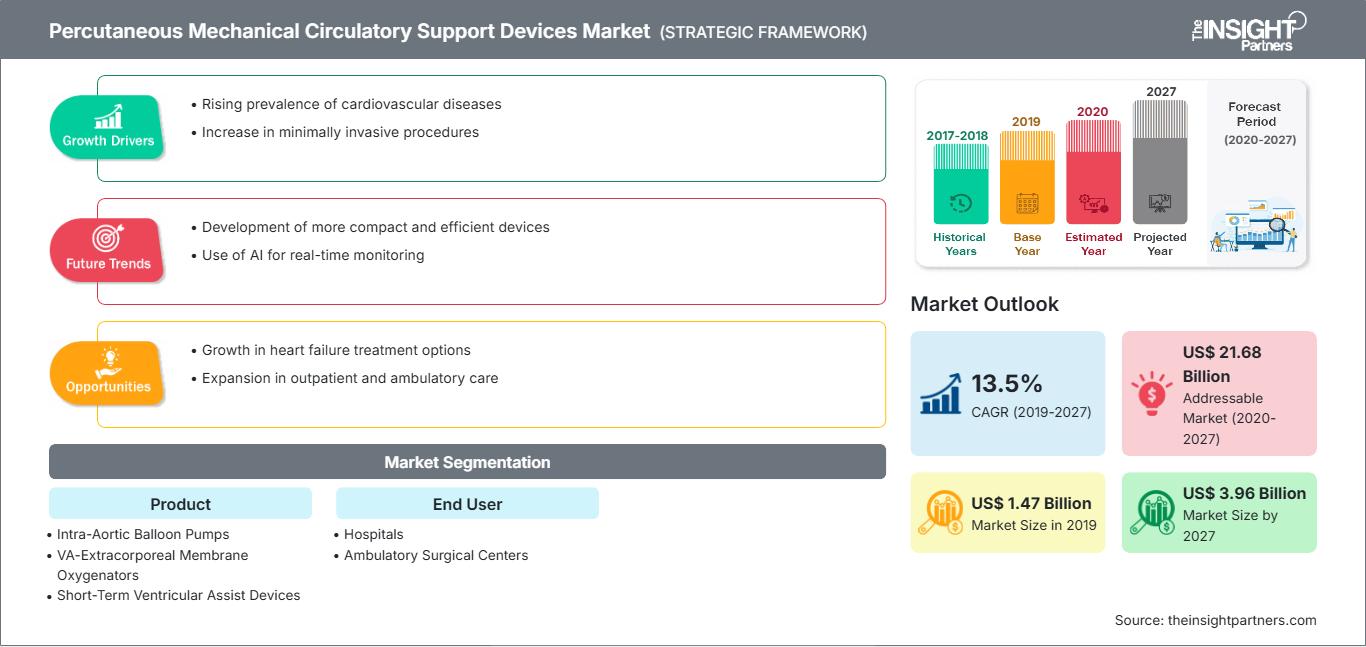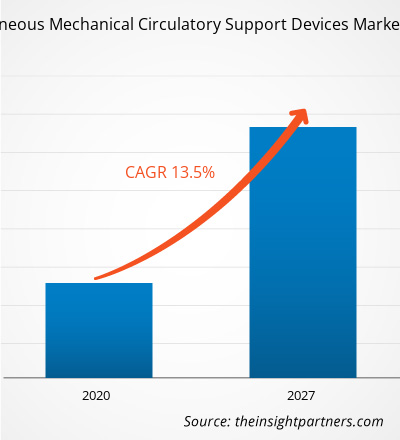El mercado de dispositivos de asistencia circulatoria mecánica percutánea se valoró en 1.474,28 millones de dólares estadounidenses en 2019 y se prevé que alcance los 3.964,75 millones de dólares estadounidenses en 2027; se espera que crezca a una tasa de crecimiento anual compuesta (TCAC) del 13,5% durante el período 2020-2027.
Los dispositivos de asistencia circulatoria mecánica percutánea ofrecen una solución eficaz y rápida para ralentizar el deterioro hemodinámico en pacientes con insuficiencia cardíaca descompensada y shock cardiogénico, hasta que se encuentre una estrategia más definitiva para su recuperación. Las principales funciones de estos dispositivos incluyen mejorar el gasto cardíaco, reducir el volumen ventricular y las presiones de llenado, aumentar la perfusión coronaria y mantener la perfusión de los órganos vitales.
Perspectivas del mercado:
Aumento de la población geriátrica
Se anticipa un alto crecimiento del mercado debido al aumento de la población geriátrica mundial. Tanto en hombres como en mujeres, el riesgo de enfermedades cardiovasculares aumenta con la edad. Los vasos sanguíneos envejecidos son menos flexibles, lo que reduce el flujo sanguíneo. Por lo tanto, el riesgo de cardiopatía es elevado en la población de edad avanzada. Además, según las Estadísticas de Enfermedades Cardíacas y Accidentes Cerebrovasculares de 2018, la edad promedio del primer infarto es de 65,6 años para los hombres y de 72,0 años para las mujeres. También se menciona que la incidencia anual de infartos en Estados Unidos es de 720.000 nuevos casos y 335.000 infartos recurrentes. Asimismo, según los Institutos Nacionales de la Salud (NIH), se proyecta que la población estadounidense mayor de 65 años casi se duplicará en las próximas tres décadas, pasando de 48 millones a 88 millones para 2050. Las enfermedades cardiovasculares (ECV) en los adultos mayores estadounidenses representan una enorme carga en términos de mortalidad, morbilidad, discapacidad, deterioro funcional y costos de atención médica. Un estudio retrospectivo realizado por la Universidad de Pittsburgh en 2015 indica que la prevalencia de enfermedades cardiovasculares (ECV), incluyendo hipertensión, cardiopatía isquémica, insuficiencia cardíaca y accidente cerebrovascular, aumenta desde aproximadamente el 40 % en hombres y mujeres de 40 a 59 años, hasta el 70-75 % en personas de 60 a 79 años y el 79-86 % en personas de 80 años o más. Por lo tanto, el creciente envejecimiento de la población, que conlleva un mayor riesgo de insuficiencia cardíaca y choque cardiogénico, incrementa las aplicaciones de dispositivos de asistencia circulatoria mecánica percutánea y, en consecuencia, favorece el crecimiento del mercado.
Obtendrá personalización gratuita de cualquier informe, incluyendo partes de este informe, análisis a nivel de país y paquetes de datos de Excel. Además, podrá aprovechar excelentes ofertas y descuentos para empresas emergentes y universidades.
Mercado de dispositivos de asistencia circulatoria mecánica percutánea: Perspectivas estratégicas

- Obtenga las principales tendencias clave del mercado que se describen en este informe.Esta muestra GRATUITA incluirá análisis de datos, que abarcarán desde tendencias de mercado hasta estimaciones y pronósticos.
Información de mercado basada en productos
El mercado de dispositivos de asistencia circulatoria mecánica percutánea se divide en tres segmentos: balón de contrapulsación intraaórtico (BCIA), oxigenación por membrana extracorpórea venoarterial (ECMO-VA) y dispositivos de asistencia ventricular a corto plazo (DAVI). En 2019, el segmento de BCIA representó la mayor cuota de mercado. Se prevé que el segmento de DAVI crezca a una tasa de crecimiento anual compuesta (TCAC) del 14,0 % durante el período de pronóstico.
Información de mercado basada en el usuario final
El mercado de dispositivos de asistencia circulatoria mecánica percutánea se segmenta por usuarios finales en hospitales, centros quirúrgicos ambulatorios y otros. En 2019, el segmento de hospitales representó la mayor cuota de mercado y se prevé que crezca a una tasa de crecimiento anual compuesta (TCAC) del 14,2 % durante el período de pronóstico.
Las empresas suelen adoptar estrategias de lanzamiento y aprobación de productos para expandir su presencia y cartera de productos a nivel mundial y satisfacer la creciente demanda.
Además, las empresas que operan en el mercado de dispositivos de asistencia circulatoria mecánica percutánea adoptan la estrategia de expansión para ampliar su base de clientes a nivel mundial, lo que les permite mantener su marca globalmente. Por ejemplo, en junio de 2016, Medtronic lanzó Beacon, un servicio de gestión de cuidados para pacientes con insuficiencia cardíaca de alto riesgo. Este servicio combina datos de desfibriladores cardioversores implantables (DCI) o dispositivos de terapia de resincronización cardíaca (TRC) de Medtronic con la monitorización posaguda de MCMS.
Perspectivas regionales del mercado de dispositivos de asistencia circulatoria mecánica percutánea
Los analistas de The Insight Partners han explicado en detalle las tendencias regionales y los factores que influyen en el mercado de dispositivos de asistencia circulatoria mecánica percutánea durante el período de previsión. Esta sección también analiza los segmentos de mercado y la distribución geográfica de estos dispositivos en Norteamérica, Europa, Asia Pacífico, Oriente Medio y África, y Sudamérica y Centroamérica.
Alcance del informe de mercado de dispositivos de asistencia circulatoria mecánica percutánea
| Atributo del informe | Detalles |
|---|---|
| Tamaño del mercado en 2019 | 1.470 millones de dólares estadounidenses |
| Tamaño del mercado para 2027 | 3.960 millones de dólares estadounidenses |
| Tasa de crecimiento anual compuesto global (2019 - 2027) | 13,5% |
| Datos históricos | 2017-2018 |
| período de previsión | 2020-2027 |
| Segmentos cubiertos | Por producto
|
| Regiones y países cubiertos | América del norte
|
| Líderes del mercado y perfiles de empresas clave |
|
Densidad de los participantes en el mercado de dispositivos de asistencia circulatoria mecánica percutánea: comprensión de su impacto en la dinámica empresarial.
El mercado de dispositivos mecánicos de asistencia circulatoria percutánea está experimentando un rápido crecimiento, impulsado por la creciente demanda de los usuarios finales debido a factores como la evolución de las preferencias de los consumidores, los avances tecnológicos y una mayor concienciación sobre los beneficios del producto. A medida que aumenta la demanda, las empresas amplían su oferta, innovan para satisfacer las necesidades de los consumidores y aprovechan las nuevas tendencias, lo que impulsa aún más el crecimiento del mercado.

- Obtenga una visión general de los principales actores del mercado de dispositivos de asistencia circulatoria mecánica percutánea.
Mercado global de dispositivos de asistencia circulatoria mecánica percutánea – Por producto
- Bombas de balón intraaórtico
- VA-Oxigenación por membrana extracorpórea (ECMO)
- Oxigenadores
- Dispositivos de asistencia ventricular (DAV) a corto plazo
- Impella
- Corazón en tándem
Mercado global de dispositivos de asistencia circulatoria mecánica percutánea – Por usuario final
- hospitales
- Centros quirúrgicos ambulatorios
- Otros
Dispositivos de asistencia circulatoria mecánica percutánea a nivel mundial – Por geografía
- América del norte
- A NOSOTROS
- Canadá
- México
- Europa
- Francia
- Alemania
- Italia
- Reino Unido
- España
- El resto de Europa
- Asia Pacífico (APAC)
- Porcelana
- India
- Corea del Sur
- Japón
- Australia
- Resto de Asia Pacífico
- Oriente Medio y África (MEA)
- Sudáfrica
- Arabia Saudita
- Emiratos Árabes Unidos
- Resto de Oriente Medio y África
- Sudamérica (SAM)
- Brasil
- Argentina
- El resto de SAM
Perfiles de empresas
- Abad.
- Medtronic
- Getinge AB
- Teleflex Incorporated
- LivanovaPlc (Cardiacassist, Inc.).
- Abiomed
- Eurosets
- Corazón de Berlín
- Jarvik Heart, Inc.
- CardioBridge GmbH
- Análisis histórico (2 años), año base, pronóstico (7 años) con CAGR
- Análisis PEST y FODA
- Tamaño del mercado, valor/volumen: global, regional y nacional
- Industria y panorama competitivo
- Conjunto de datos de Excel
Informes recientes
Testimonios
Razón para comprar
- Toma de decisiones informada
- Comprensión de la dinámica del mercado
- Análisis competitivo
- Información sobre clientes
- Pronósticos del mercado
- Mitigación de riesgos
- Planificación estratégica
- Justificación de la inversión
- Identificación de mercados emergentes
- Mejora de las estrategias de marketing
- Impulso de la eficiencia operativa
- Alineación con las tendencias regulatorias




















 Obtenga una muestra gratuita para - Mercado de dispositivos de soporte circulatorio mecánico percutáneo
Obtenga una muestra gratuita para - Mercado de dispositivos de soporte circulatorio mecánico percutáneo